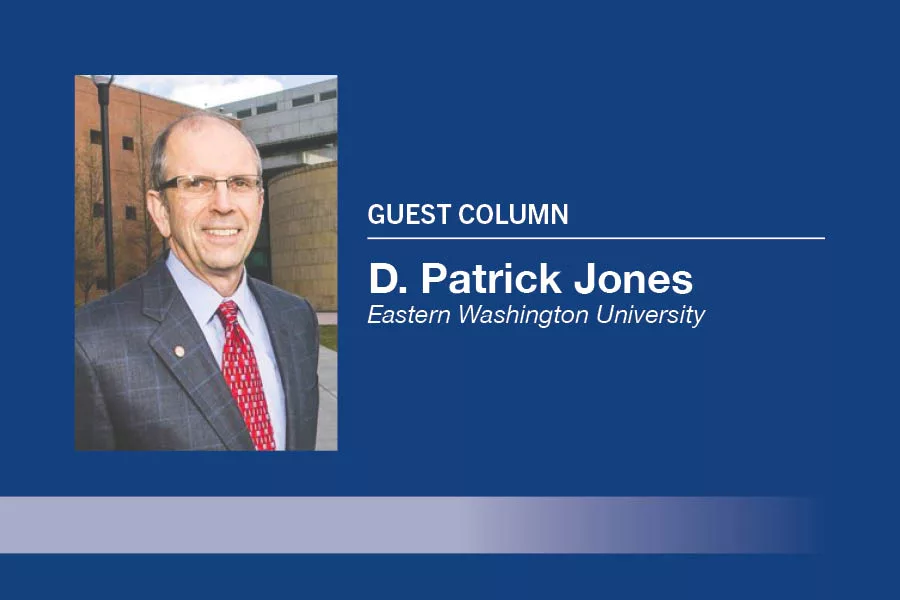
Home » For typical student, post-secondary education is still worth it
For typical student, post-secondary education is still worth it

May 15, 2025
“Higher ed isn’t worth it anymore.” “You don’t need to go to college to get a good job.” Sound familiar?
The data for local public high school graduates show that many students have recently come to believe this. Since the start of the pandemic, the share of area public high school graduates going on to some post-secondary has plunged relative to a decade ago.
The accompanying graph from Benton-Franklin Trends depicts this decline. The lower part of each bar displays the share of public high school graduates who enrolled in a two-year institution within a year of graduation. The upper part of the bar shows the share of public high school seniors who enrolled in a four-year institution within 12 months of graduation. The scope of post-secondary schools is broad: any private (non-for-profit) or public, and located anywhere in the U.S.
The most recently posted data, for the class of 2023, shows that among the eight school districts in the two counties, about a quarter were enrolled in a two-year school within a year of graduation. The share of the class enrolled in a four-year school was a bit less, at 24%. Altogether, a total of 48% of the graduating class in eight districts enrolled in higher ed somewhere in the country.
While this represents a gain from the trough reached by the seniors graduating in 2020, about 42%, college-going has definitely shifted downward from a decade ago. The share of the local class of 2014 going on to some post-secondary schooling was nearly 56%. The graph reveals that the local peak of college-going behavior was reached by the class of 2008.
Note, too, that 15 years ago, the gap between local students and the Washington state average of college-going was minimal. A narrow gap hasn’t been the case for several years. What has changed?
 Courtesy Benton-Franklin Trends
Courtesy Benton-Franklin TrendsJob openings
The local labor market certainly hasn’t. Every month, Washington State Employment Security economists list, for each county, the top 20 occupations posted by local employers. For years, technical and professional occupations have dominated the top 20 listings here.
Consider the area postings for the most recent month. For Benton County, the No. 1 occupation “in demand” was registered nurses, with a whopping 702 openings. Project management specialists ranked fourth, medical managers fifth, civil engineers sixth, mechanical engineers seventh, engineering managers 11th, general managers 12th, general computer occupations 13th, licensed practical nurses 14th, occupational therapists 15th, and physical therapists 16th.
No other county in Eastern Washington shows openings so tilted toward occupations with such high formal education requirements.
For Franklin County, the tilt is not as pronounced. But post-secondary occupations are not absent. Nursing leads the list here, too. Financial managers rank sixth, CEOs 11th, and teaching assistants 16th.
The opportunities, in other words, for local students to ultimately land local jobs that pay well are wide.
Wage premiums
A large literature on the salary “premium” of a higher education exists. Take a recent analysis of national data by the U.S. Bureau of Labor Statistics (2024). Relative to those whose highest attained degree is a high school diploma, those with an associate degree currently enjoy an 18% annual wage premium. Those with a bachelor’s, a 66% premium. And those with a Ph.D., a 145% (!) premium.
Besides earnings, premium to being employed is apparent. The national unemployment rate for those with an associate’s degree is only two-thirds as large as those whose highest attained degree is from high school. Those with a bachelor’s, 60% as high. And those with a Ph.D., a mere 29% of the unemployment rate for those with only a high school diploma.
The typical counter to these comparisons is that college, especially four-year institutions, costs too much. As the retort goes, once costs are included, the calculus doesn’t pencil out.
A very recent study (2025) from economists at the New York Federal Reserve Bank doesn’t support that claim. Using a representative national sample over the years 1970 through 2024, the study looks at the return on investment for the median graduate. The calculation first considers the wage premium of one with a bachelor’s degree to a holder of a high school degree only.
Costs covered by the study include both average direct and indirect costs. Direct costs consist of tuition (net of financial aid), books and fees, but not room and board. These are expenses incurred by students and non-students alike. Indirect costs are the opportunity costs of earnings foregone over the assumed four-year period of obtaining a degree.
Their finding: the return to a college education, once costs are considered, remains substantial for the college graduate earning the median national wage. The economists’ calculations put the ROI for bachelor’s degree holders at 12.4% in 2024.
As in most economic research, caveats apply.
First, the result is only for those who graduate; college dropouts may not enjoy a wage premium.
Second, the use of the median implies that half of graduates do not earn this level and may not show much of a wage premium. The characteristics of those below the median are taken up by the authors’ subsequent research.
Suffice to say, the choice of a major and subsequently, occupation matters.
For the typical student, however, college pays off.
D. Patrick Jones is the executive director for Eastern Washington University’s Institute for Public Policy & Economic Analysis. Benton-Franklin Trends, the institute’s project, uses local, state and federal data to measure the local economic, educational and civic life of Benton and Franklin counties.
Latest News Local News Education & Training Labor & Employment
KEYWORDS May 2025
Related Articles
Related Products





